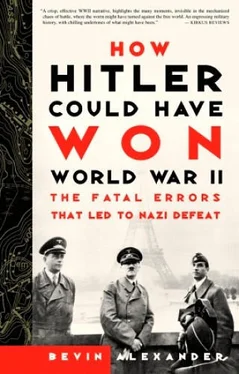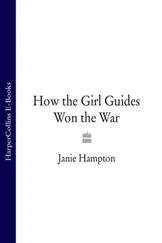But as soon as they heard the order, Rommel’s men moved fast, piled into any vehicles remaining, and escaped to the west, since the British were advancing slowly and hesitantly. Nevertheless, the delay imposed by Hitler caused Rommel to lose most of his remaining armor and a large number of the nonmotorized Italian infantry (about 20,000), who could not escape the British mobile columns.
Over the next few days, British attempts to cut off the retreating Axis troops failed because the turning movements were too narrow and too slow. The final blow to British hopes came on November 6, when heavy rain stopped pursuit. From this point on, 8th Army could not catch Rommel, and he slowly withdrew toward Tripolitania.
The British lost 13,500 men, but captured 7,900 Germans and 20,000 Italians, and killed about 2,000. Most of the remainder got away, though only 5,000 Germans and fewer Italians were able to keep their weapons.
Rommel proposed the correct strategic solution to his superiors—withdraw at once all the way to Wadi Akarit, 225 miles west of Tripoli near Gabès, Tunisia, and 45 miles beyond the Mareth line, a fortified barrier built by the French in 1939–1940. Wadi Akarit was much more defensible than the Mareth line, having only a fourteen-mile frontage between the sea and a salt marsh inland. But Mussolini and Hitler rejected the recommendation and insisted on holding one defensive line after another— Mersa el Brega, Buerat, and Tarhuna-Homs. Yet the work of fortifying these lines was useless, because the British could swing around the flank of all of them.
“If only the Italian infantry had gone straight back to the Gabès line and begun immediately with its construction, if only all those useless mines we laid in Libya had been put down at Gabès, all this work and material could ultimately have been of very great value,” Rommel wrote.
In hopes of getting the Fuehrer to face reality, Rommel flew to his headquarters at Rastenburg on November 28, 1942. He got a chilly reception, and when he suggested that the wisest course would be to evacuate North Africa, in order to save the soldiers to fight again, “the mere broaching of this strategic question had the effect of a spark in a powder keg.” Hitler flew into a rage, accusing members of the panzer army of throwing away their weapons.
“I protested strongly, and said in straight terms that it was impossible to judge the weight of the battle from here in Europe,” Rommel wrote afterward. “Our weapons had simply been battered to pieces by the British bombers, tanks, and artillery, and it was nothing short of a miracle that we had been able to escape with all the German motorized forces, especially in view of the desperate fuel shortage.”
But Hitler would listen to no further argument.
“I began to realize that Adolf Hitler simply did not want to see the situation as it was,” Rommel wrote in his journal.
Hitler finally said he would do everything possible to get supplies to Rommel, and Reichsmarschall Hermann Göring would accompany him to Italy to work things out. Rommel rode with Göring in his private train to Rome.
“The situation did not seem to trouble him in the slightest,” Rommel wrote. “He plumed himself, beaming broadly at the primitive flattery heaped on him by imbeciles from his own court, and talked of nothing but jewelry and pictures.” Göring had stolen hundreds of masterpieces from art museums all over occupied Europe.
As Rommel suspected, Göring did nothing to induce the Italians to make greater efforts to supply the army in Africa. But Rommel, by the time he turned back to Africa on December 2, had gained permission from Mussolini to withdraw his forces to Buerat, 240 miles west of Mersa and 180 miles east of Tripoli. This improved the supply situation and saved the army for the moment, but Mussolini and Hitler resolved that Buerat “must be held under all circumstances and with all means.”
This was unrealistic because Buerat could be flanked on the south. Rommel, after much pressure, secured from Marshal Ettore Bastico, the Axis supreme commander in Africa, authorization to retreat to Tarhuna-Homs, sixty miles east of Tripoli, when the British attack finally came on January 15, 1943.
Rommel told everybody in authority that the Axis should abandon Libya and retreat to the Mareth line, since Hitler and Mussolini would not consider the better Wadi Akarit position. There Rommel could link up with Axis forces in Tunisia, and, because of the mountains, would be secure from encirclement. On the new line the army could revive itself and, should the occasion arise, go over to the offensive—“be it to the west or the east.” But once again he got no response.
The British overran the Buerat position in two days, but were stopped at Tarhuna-Homs on January 19 by Axis artillery fire. When the British swung around to the south to encircle the position, Rommel sent his motorized forces to shield the flank and ordered all his infantry out of Tarhuna-Homs. Within hours the foot soldiers were gone.
The British continued on westward, aiming to encircle Tripoli from the west and to close the entire German-Italian Panzer Army Africa into a caldron.
Seeing this, Rommel on January 23 ordered all forces to withdraw west of Tripoli, to take all war material possible, and to destroy the rest. Rommel’s attention now focused on getting the 30,000 men in the nonmotorized Italian infantry divisions and his supplies to the Mareth line. He didn’t wait for approval from Mussolini or Hitler.
Rommel’s desperate bid succeeded, primarily because Montgomery stopped at Tripoli to bring up new supplies. The Germans and Italians had time to withdraw the last of their armor and motorized forces into the Mareth line.
On January 26, Rommel received a signal from the Italian high command relieving him of duty at such time as he himself was to determine. The reason cited was Rommel’s physical condition—he was suffering violent headaches and “nervous exhaustion”—but the real reason was pay-back for his defiance of Hitler and Mussolini, and for telling them the truth about the situation in Africa. Italian General Giovanni Messe was to take command.
But Rommel had one more trick up his sleeve. And before he left Africa, he was going to show it.
With the Tunisian campaign stalled in winter mud, Roosevelt and Churchill decided on a meeting to plot future operations.
When Stalin said he could not come to a conference, Churchill pushed for a meeting at Marrakech, a favorite haunt of his in the Atlas Mountains in southern Morocco. But Roosevelt insisted on Casablanca, close to American troops. The conference began on January 14, 1943.
At the conference, Britain and the United States agreed on a strategic bombing campaign against German industry and cities, which fitted in with British ideas of a war of attrition. Top RAF and U.S. air commanders saw strategic bombing as possibly decisive, leading to German surrender and fewer battlefield losses. There was no disguising that the campaign was aimed at civilian targets to undermine the morale of the German people.
While the British continued to concentrate on heavy nighttime area raids that laid down massive loads, especially of incendiaries, burning huge portions of German cities, the Americans put much faith in precision bombing of specific targets with their four-engine B-17 Flying Fortresses, which air enthusiasts claimed could fend off German fighters with their .50-caliber machine guns, and could bomb far into the depths of Germany in daylight.
But as the raids extended into Germany beyond the range of fighter protection, the bomber fanatics were found to be wrong: the B-17s were highly vulnerable to German fighters, and losses became prohibitive. In time the Americans hit upon a solution: the P-51 Mustang fighter with extra fuel tanks on the wings, which could be dropped off in flight. The Mustang was the best fighter to come out of the war, and it made long-range daylight bombing feasible. The campaign commenced in 1943, but did not reach its zenith until autumn 1944, when increasing aircraft production allowed full implementation of the theory.
Читать дальше


![Джонатан Димблби - Barbarossa - How Hitler Lost the War [calibre]](/books/385421/dzhonatan-dimblbi-barbarossa-how-hitler-lost-the-w-thumb.webp)









